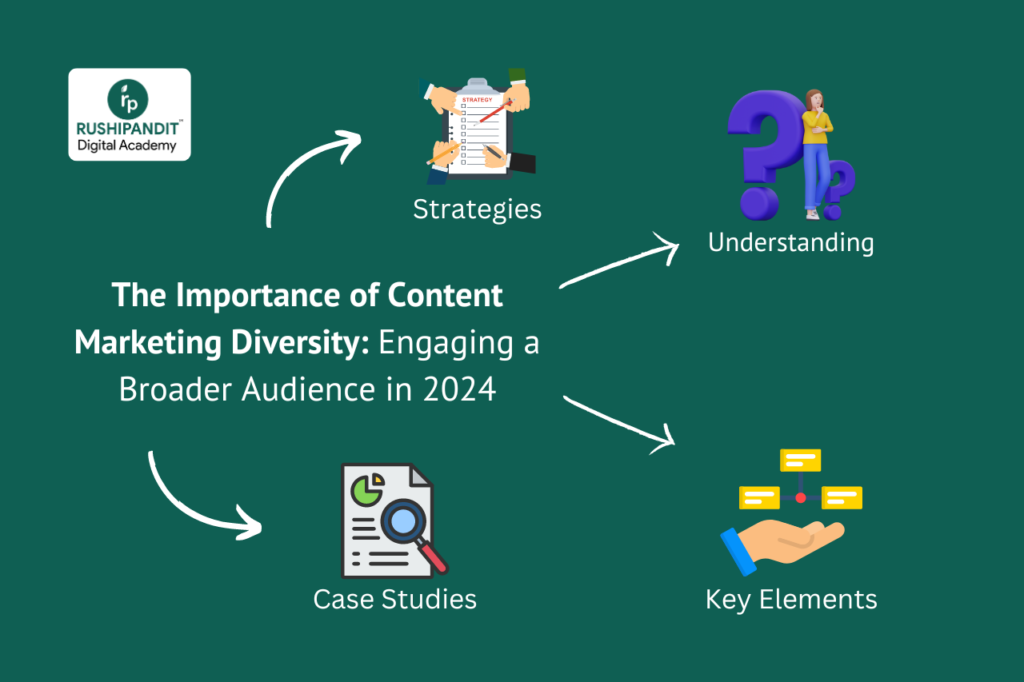In today’s dynamic digital landscape, content diversity is not just a buzzword—it’s a critical component of successful marketing strategies. As audiences become more varied and discerning, brands must create and distribute diverse content to resonate with different segments and foster deeper connections. Here’s why content diversity is essential in marketing and how you can effectively implement it in your strategy.
Table of Contents
ToggleUnderstanding Content Diversity

Content diversity involves producing and sharing a variety of content types and formats to cater to different audience preferences, learning styles, and engagement methods. It goes beyond simply mixing up blog posts and videos; it encompasses the breadth of topics, perspectives, and voices represented in your content.
Why Content Diversity Matters

1.Broadening Audience Reach:
Different people consume content in different ways. By diversifying your content, you can reach a wider audience, including those who prefer reading, watching, or interacting with content.
2.Enhancing Engagement:
Diverse content keeps your audience engaged. When you offer various formats and topics, you cater to different interests and keep your content fresh and exciting.
3.Boosting SEO:
A mix of content types—such as articles, videos, infographics, and podcasts—can improve your search engine rankings. Different formats can target various keywords and increase your visibility across multiple platforms.
4.Building Inclusivity and Representation:
Showcasing diverse voices and perspectives in your content can help your brand appeal to a broader, more inclusive audience. It demonstrates your commitment to diversity and can foster stronger community ties.
5.Adapting to Different Learning Styles:
People absorb information differently. Some prefer visual content like videos and infographics, while others might favor in-depth articles or interactive quizzes. Diverse content ensures you cater to all learning styles.
Key Elements of Content Diversity

1. Format Diversity:
– Blogs and Articles: In-depth content that offers valuable information and insights.
– Videos: Engaging and visually appealing content suitable for tutorials, testimonials, and storytelling.
– Infographics: Easily digestible visual representations of data and concepts.
– Podcasts: Convenient audio content for on-the-go listeners.
– Interactive Content: Quizzes, polls, and interactive infographics that engage users actively.
2.Topic Diversity:
– Cover a broad range of topics within your niche to address different aspects of your audience’s interests and needs.
3.Voice and Perspective Diversity:
– Include content from different voices within your organization and guest contributors to offer varied perspectives and expertise.
4.Platform Diversity:
– Distribute your content across multiple platforms—such as your website, social media, email newsletters, and third-party sites—to reach different segments of your audience.
Strategies for Implementing Content Diversity

1.Conduct Audience Research:
Understand your audience’s preferences, behaviors, and needs. Use analytics tools and surveys to gather insights into what types of content resonate most with different segments.
2.Create a Content Calendar:
Plan your content strategy to ensure a balanced mix of formats, topics, and voices. A content calendar helps you organize and schedule diverse content effectively.
3.Leverage User-Generated Content:
Encourage your audience to create and share their own content related to your brand. This not only adds variety but also fosters a sense of community and trust.
4.Collaborate with Diverse Contributors:
Partner with influencers, industry experts, and guest writers from diverse backgrounds to enrich your content with different viewpoints and expertise.
5.Experiment and Analyze:
Continuously test different types of content and analyze their performance. Use the data to refine your strategy and focus on what works best for your audience.
Case Studies: Brands Excelling in Content Diversity
– Coca-Cola:
Coca-Cola’s content strategy includes a mix of videos, social media posts, blogs, and interactive campaigns. Their “Share a Coke” campaign, which featured personalized bottles, included user-generated content that celebrated diversity and inclusivity.
– HubSpot:
HubSpot offers a wide variety of content types, including blogs, eBooks, videos, webinars, and podcasts. They cover an extensive range of topics related to marketing, sales, and customer service, catering to different audience needs and preferences.
– Nike:
Nike excels in storytelling through diverse content formats, including inspirational videos, athlete stories, social media campaigns, and interactive experiences. Their content often highlights diverse voices and promotes inclusivity.
Conclusion:
In 2024 and beyond, content diversity is vital for brands looking to engage a broader audience, boost engagement, and stay relevant in an ever-changing digital landscape. By offering a rich mix of content types, covering a wide range of topics, and including diverse voices, you can create a more inclusive and effective marketing strategy.
Ready to diversify your content and connect with a wider audience? Start implementing these strategies today and watch your engagement soar!


